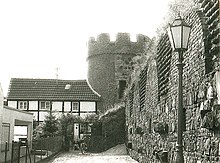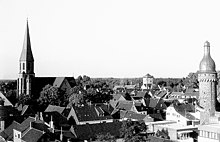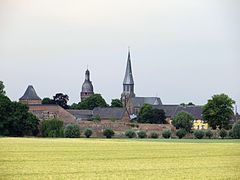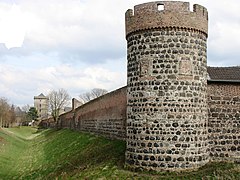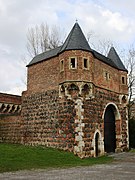City of Zons
|
City of Zons
City of Dormagen
|
||
|---|---|---|
| Coordinates: 51 ° 7 ′ 19 ″ N , 6 ° 50 ′ 34 ″ E | ||
| Height : | 40 m | |
| Area : | 18.09 km² | |
| Residents : | 5371 (Jun 30, 2010) | |
| Population density : | 297 inhabitants / km² | |
| Incorporation : | 1st January 1975 | |
| Postal code : | 41541 | |
| Area code : | 02133 | |
|
Location of the city of Zons in North Rhine-Westphalia |
||
City of Zons [ ˈtsoːns ] (formerly known as Feste Zons ) is a town on the left bank of the Rhine on the Lower Rhine . Since the municipal reorganization in 1975, it has been a district of the city of Dormagen in the Rhine district of Neuss with around 5,370 inhabitants (as of June 30, 2010).
geography
Zons borders the Rhine in the east . On the opposite side of the Rhine, there is a three kilometer long path from the ferry terminal to Düsseldorf- Urdenbach , which is northeast of Zons. To the south of Zons, the district is surrounded by fields and a few poplar trees. Passing two Aussiedlerhöfe , after two kilometers the village of Dormagen- Rheinfeld follows . To the west there are extensive pastures with isolated willow trees and, at some distance, the small street hamlet Nachtigall on federal road 9 . To the northwest, Zons borders on the Zonser Heide and to the north, after two kilometers, the village of Stürzelberg follows . To the northeast, near the Rhine, an extension of the Grind nature reserve borders the Zons ferry and shipping pier.
history
middle Ages
Zons is documented for the first time via the so-called testament of Bishop Kunibert of Cologne , which was written around the middle of the 7th century, but has only come down to us in a version from the late 11th century. This is where the oldest form of name Zuonizo or Zuonice is handed down, the origin of which has not yet been clarified. In a deed of donation from Bishop Heribert of Cologne from 1019, the name for Zons is given as the location of the later House Bürgel as "Burgula bei Zünce ".
Archaeological finds from the 7th century indicate a settlement in Zons dating back to the Merovingian Age, the exact location of which is still unclear. Already in a document of 1057 which gave Archbishop Anno II. Cologne the queen Richeza next 100 Mark several villas on the outskirts of Cologne. One of these villas was in Zons. This award was in return for the Queen, who had made various donations to Erzköln.
Written sources prove that the Archbishop of Cologne had a court yard in Zons since at least the beginning of the 12th century. In 1386 the lay judges of Hilden confirmed that the same court rights as in the peasantry of Zons were valid for their honors . These court rights corresponded to the rights that were customary for the old Sal or Fronhöfe.
In the 1980s, archaeological investigations in the Zons castle area uncovered building foundations that are interpreted as the remains of the landlord's own church and thus as part of the Fronhof complex.
In 1372 the Archbishop of Cologne Friedrich III. the Rhine toll from Neuss to Zons. The relocation of the customs post was expressly confirmed by King Wenceslaus on July 6, 1376. Furthermore, in 1388 the Archbishop managed to get Duke Wilhelm von Jülich-Geldern to cede his previous rights as Vogt for Zons to the Archdiocese.
To protect the customs post, the construction of the Friedestrom Castle customs fortress began in 1373 . In December of the same year Zons was promoted to town. The privileges and regulations corresponded to those of the city of Brühl from 1285.
With the construction of the customs fortress, the construction of a city fortification with walls and ditches began. However, it was stipulated in the conditions for the town elevation that the scope and execution of the town fortifications of Kurköln had to be “approved”. In addition, the keys to the city gates had to be deposited in the customs fortress in the evening. These specifications were intended to ensure unrestricted access to the customs post by Kurköln in the long term.
The core of the fortress as a whole was formed by the heavily fortified Friedestrom Castle, which was the seat of the episcopal mayor . Administration and security of customs and the administration of the newly created Zons office also had their seat in the castle. The planned construction of the customs fortress with city wall was probably completed by the 15th century.
The rectangular to trapezoidal city is surrounded by a reinforced basalt wall that extends approx. 300 m in north-south direction and 250 m in west-east direction. At the corner points there are differently designed towers: to the northeast the rectangular Rhine, Zoll or Peters Tower, to the northwest the round Krötschenturm, southwest the round mill tower (conversion from the defense tower to the mill tower ( Bärwindmühle ) still in the late Middle Ages ), and to the southeast the castle tower In the inner city on the castle wall the round Juddeturm (35 m high, 24 m to the lower edge of the roof, baroque hood 11 m). The name Juddeturm probably goes back to the Cologne patrician family Judde.
Two public gates led into the city: the Rhine gate in the north, the field gate in the west. The former was partially removed in the 19th century, the latter almost completely. A third outer gate (South Gate), which is the best preserved, formed the access from the kennel into the bailey . The location of the older Zonser village settlement is currently only possible based on the names of the fields and the terrain. The field name “Im Hofstädtchen” on today's Aldenhovenstrasse not far from the old town could refer to this settlement, whereby the paths crossing at this point are also to be seen as a possible indication.
The small town only had 124 house places. The village of Stürzelberg , part of the village of Horrem and the Bürgel house on the right bank of the Rhine also belonged to the Zons office . Haus Bürgel and Zons originally belonged together ecclesiastically and judicially. It was not until 1423 that a small baptistery was built in Zons by order of Archbishop Dietrich II. The main and full church remained unchanged from the church in Bürgel, which in the meantime was on the other right bank of the Rhine due to the relocation of the Rhine at the end of the 14th century. Since visiting the church was very difficult due to the location on the right bank of the Rhine, the baptistery was elevated to a parish church with all rights by Vicar General Peter Propper in 1593. The church in Zons continued to belong to a common parish with that in Bürgel .
The parish right over the Bürgel / Zons parish was held by the Brauweiler monastery until 1803 . The Rhine toll town of Zons in the Electorate of Cologne is considered to be one of the best preserved late medieval urban complexes on the Lower Rhine. Until 1794 the Amt Zons belonged to Kurköln , bounded to the south by the Jülich enclave of Dormagen ( Amt Bergheim ), to the southwest by the Electorate Hackenbroich , to the west by the Kurköln parish of Nievenheim as part of the Dingstuhl Hülchrath , to the northwest by the Electorate of Cologne Uedesheim (both Amt Hülchrath and Erprath ), on the right bank of the Rhine through the monasteries Urdenbach and Baumberg in the Duchy of Berg . However, at the beginning of the 15th century, Archbishop Dietrich II von Moers had to pledge to the Cologne cathedral chapter due to the high costs of the Soest feud . This pledge still existed in 1794.
- The Zons city wall
Modern times
From the pledge in 1463 by Archbishop Dietrich II of Moers to the Cologne cathedral chapter until 1796, the city and office of Zons were a kind of subordinate rule of the chapter. With the occupation of the Left Bank of the Rhine by French revolutionary troops in 1794, membership of the Electorate of Cologne ended; Zons became French, initially as a canton and municipality and from 1798 to 1814 as part of the canton of Dormagen in the Arrondissement de Cologne in the Département de la Roer . With the Treaty of Lunéville in 1801, the entire area on the left bank of the Rhine was incorporated into France under international law .
In 1815 it was added to the Prussian territory, and in 1816 the Neuss district was formed with the Zons mayor's office , which consisted of Zons, Nachtigall, St. Peter and Stürzelberg. This had been part of the new administrative district of Düsseldorf since 1822 . Zons has been a popular destination since around 1900 . In 1904 the place received the right to use its own coat of arms. Since then, Zons has been called "city" again, even if the place remained administratively in the district of the rural communities . When it was incorporated into the city of Dormagen, which came into force on January 1, 1975, Zons was called "Feste", and since 1992 the place has been renamed "City" due to its historical significance, albeit as a pure titular city . As early as 1972, the entire old town was thoroughly renovated in a model test funded by the federal and state governments.
Population development
Zons has developed little spatially and demographically since the 14th century , which was probably primarily due to the rather unfavorable location in road traffic. Over the centuries the city was ravaged three times by severe city fires: in 1464, 1547 and 1620. While before the last city fire a certain economic boom was reported, mainly through trade, the city experienced an unsuccessful fire in the 17th century due to this fire ) Siege and heavy shelling towards the end of the Thirty Years' War , several devastating plague epidemics and frequent occupations by Cologne and French troops led to an economic and demographic decline. In 1648 there were 172 people in Zons and 49 in Stürzelberg. After a gradual increase in population, around 255 people died in the plague year of 1666 in the parish of Zons. Since around 1700 the population has increased again noticeably: in 1692 the parish had 308 inhabitants, in 1738 there were already 831 communicants and finally 1,054 in 1799. The population was almost entirely Catholic in the 18th century. During this period, only a few Jewish families lived there, the number of which had grown to almost 50 by 1806. In the course of the 19th to the beginning of the 20th century, the population increased relatively slowly, but almost continuously, compared to the general demographic development. In 1849 Zons and Stürzelberg had 2,012 inhabitants, in 1928 there were 1,306 people in Zons and 1,428 people in Stürzelberg, for a total of 2,734. On June 30, 1964, the then city of Zons, i.e. with Stürzelberg, St. Peter and Nachtigall, had 6,310 inhabitants and on June 30, 1974 already 9,715 inhabitants.
|
|
politics
mayor
- 1800–1812: Matthias Aldenhoven
- 1813–1828: Anton Baaden
- 1829–1837: Franz Michael Fischer
- 1837–1848: Peter Mathias Schumacher
- 1848–1851: Josef Schneider
- 1851–1858: Josef Hanstein
- 1858–1879: Eduard Bacciocco
- 1879–1900: Hermann Heckmann
- 1900–1909: Nikolaus Kohl
- 1909–1910: Josef Trapet
- 1910–1923: Albert Granderath
- 1923–1926: Stephan Güsgen
- 1926–1928: Emil Kirchhoff
- 1928–1945: Michael Flücken
- 1945–1946: Johann Scheer (until January 1946 only for the place Zons)
- 1945–1946: Franz Bebber (for Stürzelberg)
Honorary Mayor
- 1946: Gerhard Justenhoven
- 1946–1948: Wilhelm Fleischhauer
- 1948–1952: Bernhard Kamm
- 1952–1962: Hermann Schmitz
- 1962–1969: Georg Lerch
- 1969–1974: Hannelu Manitz (CDU), Deputy: Hans Wingerath (CDU)
City Directors
- 1946–1961: Johann Scheer
- 1961–1973: Artur Elicker
- 1973–1974: Johann Schmitz, general representative: Reinhold Schwarz
coat of arms
From 1904 until the incorporation, Zons had its own coat of arms. Blazon : "In red a silver saint on horseback, with a sword sharing his cloak with a scantily clad man standing in front of him, in the right upper corner in silver a continuous black bar cross." As the city coat of arms, often with a silver, three-tower crenellated wall crown with a black center Portal shown on the upper edge of the shield.
Declaration of coat of arms: The saint is St. Martin von Tours , the black cross in silver is the coat of arms of the Electorate of Cologne.
Economy and Infrastructure
The main occupations of the population were until modern times agriculture and livestock. In addition, the beer and wine trade and various handicrafts such as brickworking were partly of supra-local importance. The inhabitants of Stürzelberg earned their living mainly as day laborers or fishermen . A particularly prominent group of the population according to wealth and social origin were the customs officers until around 1800 , who did not have civil rights and accordingly had no civil duties to perform. Around the beginning of the 20th century there was an industrial settlement in Stürzelberg and St. Peter. No industry to speak of has established itself in Zons.
The residential development of the actual city of Zons did not grow beyond its city walls until relatively late . The first “extra muros” residential buildings were built at the beginning of the 19th century, more closed settlement areas can only be identified at the end of the 19th century. Initially, the development concentrated on the roads in the immediate vicinity of the fortress and later, especially after the Second World War , expanded to the north and west.
media
- Neuss-Grevenbroich newspaper - national daily, Neuss newspaper publisher GmbH, the Rheinische Post duly
- Shop window - local advertising paper (Tuesday & Saturday), Druck + Verlag Josef Wegener GmbH, belonging to Verlag W. Girardet GmbH & Co. KG
- Rheinischer Anzeiger - local advertising paper (Wednesday), Druck + Verlag Josef Wegener GmbH, belonging to Verlag W. Girardet GmbH & Co. KG
- Westdeutsche Zeitung , local editorial office in Neuss - regional daily newspaper, W. Girardet KG publishing house
- NE-WS 89.4 - local radio station, belonging to the Rheinische Post.
traffic
Zons is two kilometers east of federal highway 9 . The motorway connection Dormagen, Nievenheim, Zons to the A 57 is four kilometers away from Zons .
shipping
The city of Zons can also be reached by excursion boat operated by the Cologne-Düsseldorfer from Düsseldorf and Cologne . There is also a car ferry between Zons and Urdenbach .
Bus routes
Zons can be reached and left via the following lines within the Rhein-Ruhr transport association :
| line | Line course | Cycle (min.) |
|---|---|---|
| 875 | Neuss Regional Theater - Grimlinghausen - Uedesheim (Stüttgen) - St. Peter - Stürzelberg - Zons - Dormagen Bf | 60 |
| 880 | ( Gohr - Ückerath - ) Nievenheim comprehensive school - Nievenheim station - St. Peter - Stürzelberg - Zons - Dormagen station - Hackenbroich / Worringen / Rheinfeld | School traffic |
|
886 887 |
Nievenheim train station - Delrath - St. Peter - Stürzelberg - Zons - Dormagen train station - Marktplatz - Rheinfeld The lines 886 and 887 run every 60 minutes and only differ in the different routes in Rheinfeld. Both lines continue from Nievenheim train station as line 884 via Ückerath, Nievenheim and Horrem. |
30th |
| WE2 | Nievenheim comprehensive school - Nievenheim station - Delrath - St. Peter - Stürzelberg - Zons - Dormagen station - market square - Rheinfeld | 60 |
| NE2 |
Nievenheim School - Nievenheim Bf - Delrath - St. Peter - Stürzelberg - Zons - Dormagen - Dormagen Bf track from Dormagen Bf further than NE1 over Delhoven, Straberg and Nievenheim.. |
60 |
Public facilities
- primary school
- sports ground
- Tennis court
- gym
- Kindergartens
- Day care centers for the elderly
- District Museum
- District archive and international dialect archive "Ludwig Soumagne"
- Volunteer firefighter
- Supermarket
Culture and leisure
- Customs
- District Museum
- Jewish cemetery (Zons)
- Hannepützheide in the Zonser Heide; In this cultural landscape there is heather ( Calluna vulgaris ) in the former Rhine dune and a large children's playground.
- Fairy tale games at the open-air theater in Zons
- annual jousting games
- Shooting festival
Personalities
- Franz Joseph Aldenhoven , tenant of the Zonser Burg, since 1850 provisional district administrator of the Neuss district. For many years a member of the Prussian state parliament . Promoter of the Rhenish sugar industry and sugar beet cultivation .
literature
- Jörg H. Baumgarten: Zons - a city guide. Cologne, 1989. ISBN 3-87909-237-0
- Helene Blum-Spicker: 600 years of the city of Zons. 1373-1973. Dormagen, 5th edition 1985.
- Nicolaus Bömmels: The former manors in the Grevenbroich and Neuss districts. In: Almanach for the Neuss district 1979. Neuss 1979, pp. 32–51.
- Karl Emsbach: Zons - portrait of an old city. Edited by the Heimat- und Verkehrsverein der Stadt Zons eV, Dormagen, 2000. ISBN 3-926963-44-1
- Karl Emsbach: Zons. Rheinische Kunststätten, issue 496; Ed .: Rhenish Association for Monument Preservation and Landscape Protection, Neuss, 2006.
- Aenne Hansmann: History of the city and office of Zons. With a contribution by Artur Elicker, Jakob Justenhoven and Herbert Milz. Düsseldorf 1973.
- Aenne Hansmann, Margret Wensky: Rheinischer Städteatlas Zons. Delivery IV, No. 25. 1978, 2. verb. u. added edition Cologne 1990. ISBN 3-7927-1115-X
- Maria-Elisabeth Kirchhoff-Werle, Hans Georg Kirchhoff: Zons - history and stories. Historical publication series of the city of Dormagen, Vol. 11, Dormagen 1993. ISBN 3-926963-12-3
- Werner Lisken (arrangement): The families of the historic town of Zons and the Catholic parish of St. Martin (with the districts of Bürgel, Grind, Nachtigall, Sankt Peter and Stürzelberg) from 1664 to 1900. A genealogical reference work. Publications of the Gesellschaft für Familienkunde eV, Cologne headquarters, Bd. 293, Cologne 2014. ISBN 978-3-86579-108-5
- Thomas Schwabach: The development of the brick industry in Zons, city of Dormagen, Rhein-Kreis Neuss (15th-20th century) with a detailed description of the general development of the industry. History Association for Dormagen, Zons and Nievenheim eV, Dormagen 2004, ISBN 3-936975-02-7 . (With 19 plates, four maps and a family tree)
- Thomas Schwabach: The Schwieren Chronicles from Zons. Remarkable things from a small town on the Lower Rhine and its surroundings 1733–1823. Publications of the Kreisheimatbund Neuss eV No. 15, Neuss 2005, ISBN 3-9808017-9-9 . (With selected entries in high German translation)
- Detlev Zenk: Zons - old customs festivals on the Rhine. Gaasterland, Düsseldorf 2005. ISBN 3-935873-09-3 .
Web links
- Zons history and virtual tour
- Sights, events and chronicle of the Zons customs fortress
- Complete bibliography for the history of Zons
supporting documents
- ↑ Monthly of the Düsseldorfer Geschichtsverein , 1881, Issue 4, p. [39] 34.
- ^ Frank Siegmund: Merovingian time on the Lower Rhine. Rheinische Ausgrabungen 34. Rheinland-Verlag, Cologne 1998, p. 470f., Plate 255. ISBN 3-7927-1247-4
- ↑ Theodor Joseph Lacomblet, in: Document book for the history of the Lower Rhine and the Archbishopric of Cöln, document 192 , 1840, part 1, p. [139] 123. Online edition 2009 [1]
- ↑ Oediger: Regesten I, p. 24 f. No. 46 and p. 195ff. No. 658.
- ↑ Lacomblet, Theodor Joseph, in: Document book for the history of the Lower Rhine or the Archbishopric of Cologne, document no. 903. Volume 2, 1846, p. [353] 337. Digitized edition ULB Bonn
- ^ Marion Roehmer : Burg Friedestrom in Zons. Medieval ceramics and findings from a Rhenish customs fortress. Rhenish excavations 42nd Cologne 1998.
- ↑ a b Lacomblet, Theodor Joseph: Archives for the history of the Lower Rhine. In: XIV. Bürgel.Zons . Volume 2, 1857, pp. [257] 241. Online version
- ↑ a b Lacomblet, Theodor Joseph: Archives for the history of the Lower Rhine. In: XIV. Bürgel.Zons . Volume 2, 1857, pp. [358] 342. Online version
- ↑ Lacomblet, Theodor Joseph: Archive for the history of the Lower Rhine. In: XIV. Bürgel.Zons . Volume 2, 1857, p. [363] 347. Online version
- ↑ Lacomblet, Theodor Joseph: Archive for the history of the Lower Rhine. In: XIV. Bürgel.Zons . Volume 2, 1857, pp. [359] 343. Online version
- ^ Federal Statistical Office (ed.): Historical municipality directory for the Federal Republic of Germany. Name, border and key number changes in municipalities, counties and administrative districts from May 27, 1970 to December 31, 1982 . W. Kohlhammer, Stuttgart / Mainz 1983, ISBN 3-17-003263-1 , p. 294 .




